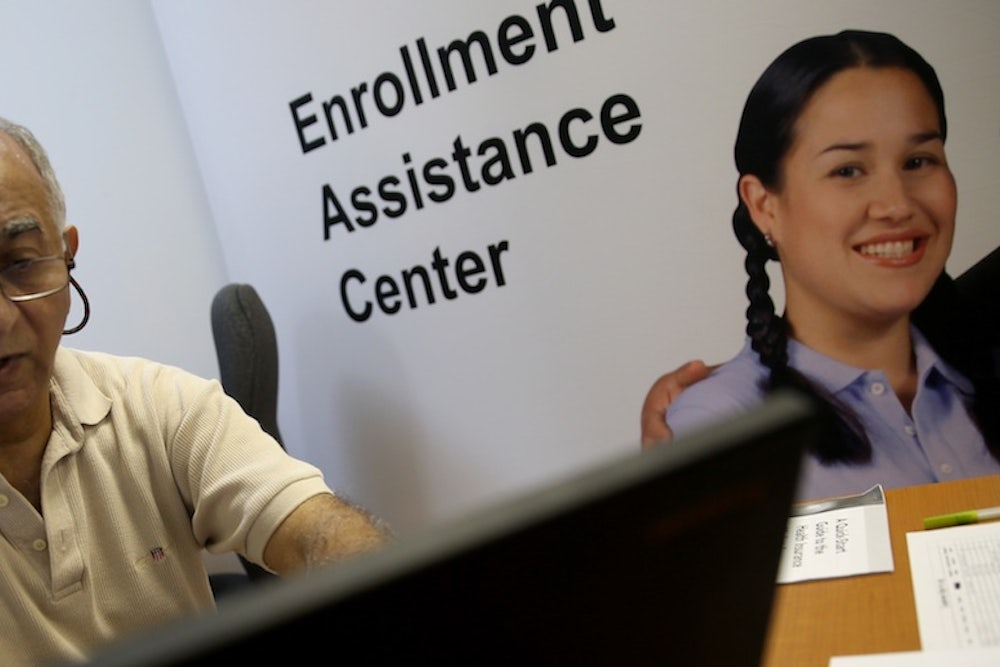The Obama Administration has released detailed information about enrollment in the Affordable Care Act—not just how many people are signing up for insurance, but also what kind of people and what plans they are choosing.
What you make of the information depends, as usual, on your expectations.
The figure bound to get most attention is the age breakdown. Insurers rely on premiums from healthier people to offset the costs of people with significant medical bills. And young people are a reasonably good proxy for healthy people—or, at least, as good a proxy as we have right now. According to a recent study by the Kaiser Family Foundation, about 40 percent of the population that could enroll in Obamacare exchange plans are between the ages of 18 and 34. But, according to the government’s new data, only 24 percent of the people signing up for coverage are in that age range. In short, the people who have gotten insurance through the Obamacare marketplaces so far are significantly older than the people who could, in theory, be buying insurance from them.
But is that really a big deal? In Massachusetts, according to analysis from MIT economist (and Obamacare architect) Jonathan Gruber, younger people tended to sign up later.
The same thing seems to be happening in Colorado, one of the states that's kept close records on age. Sarah Kliff has that story at the Washington Post.
There's no guarantee that future enrollment will follow the same pattern that it did in Massachusetts. And as Philip Klein of the Washington Examiner observes, each state market operates on its own: It's possible some states will attract plenty of healthy people, while some will not..
But thanks in part to Obamacare's built-in shock absorbers—such as a “risk corridor” program that compensates insurers for greater-than-expected losses—the danger of low enrollment among young (and healthy) people isn’t as great as commonly thought. As John Holahan, Urban Institute scholar and co-author of a report on the subject, told me recently, "It's a problem if it goes on forever, but it's not a problem if it's just year one and if enrollment is improving over time ... The system can handle it."
The new data contains some other insights. Obamacare policies fall into four different categories, depending on how much coverage they provide. The least generous available to everybody are the so-called bronze plans. But the next level up, silver plans, are proving far more popular. Sixty percent of shoppers have chosen silver plans, more than three times as many have chosen bronze. Smaller portions still selected gold or platinum, and barely anybody has opted for special catastrophic coverage plans available only to people who are under 30. One reason for silver’s popularity may be that the law provides lower income people with extra assistance to handle out-of-pocket expenses, but only if they select silver policies.
Other data in the report shows that most of the people (nearly 80 percent) are getting some kind of financial assistance. That means their household income is less than four times the poverty line, which is about $46,000 for an individual and $96,000 for a family of four. That’s very much by design: A premise of the law is that even many middle-class people need help paying for coverage.
But it’s important to remember that many people are buying coverage outside of the marketplaces, directly from insurers, and that the majority of these people are probably not getting financial assistance. In fact, the Congressional Budget Office predicted all along that the vast majority of people buying coverage through the marketplaces would be getting subsidies—which is a very long way of saying that, at least in this respect, Obamacare is unfolding in precisely the way most experts expected.
Update: I added a chart of Massachusetts enrollment, based on an item from last week, and a reference to Phil Klein's more skeptical take in the Washington Examiner.
